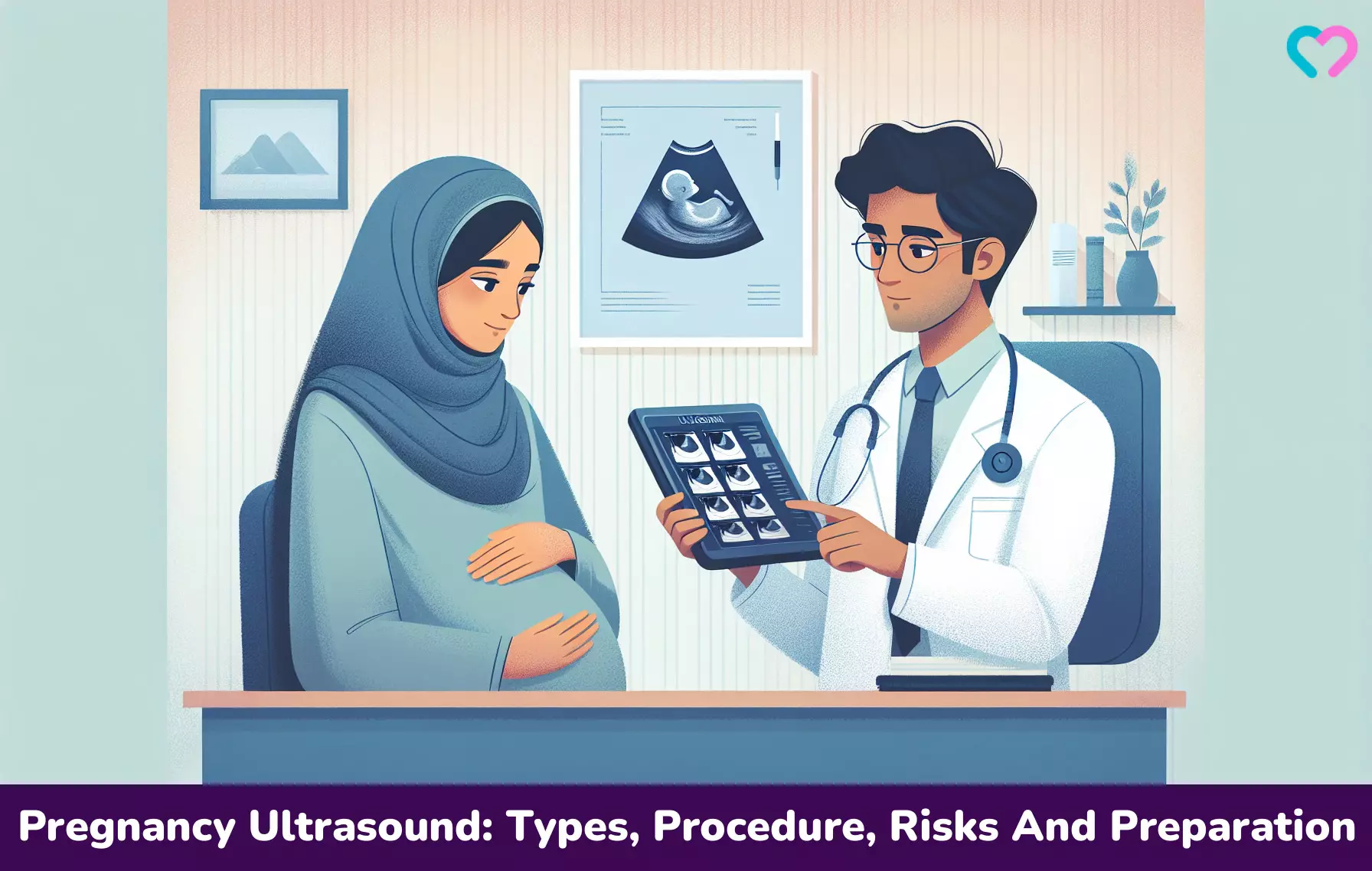
Image: iStock

Pregnancy ultrasound enables healthcare providers to identify existing problems in the growing fetus and allows parents to see their baby for the first time. As a result, ultrasounds are now an important part of routine prenatal care for most pregnant women.
Diagnostic ultrasound procedures are considered safe, and according to the American Congress of Obstetricians and Gynecologists, they do not have any adverse effects on the developing fetus (1). However, care must be taken to undergo ultrasounds under the supervision of an experienced doctor.
Read this post to know the benefits, types, and importance of pregnancy ultrasounds and when they should be done.
Key Pointers
- An ultrasound uses high-energy sound waves to examine organs and tissues inside the body.
- Ultrasounds may be transvaginal, transabdominal, 3D, 4D, or Doppler.
- Ultrasounds pose minimum risks on the developing fetus, and the benefits vastly outweigh them.
What Is An Ultrasound?
Ultrasound is defined as a procedure that uses high-energy sound waves to look at tissues and organs inside the body (2). A pregnancy ultrasound is a test that shows the development of the baby in two dimensions. During this process, the sound waves emitted from the transducer reflect after touching the baby’s body and create an image on the ultrasound screen, showing the fetus’ growth and body parts (3).
Ultrasounds can also help your healthcare provider see and monitor your baby’s growth and development. When done under the supervision of a doctor, the ultrasound is safe for you and your baby.
When Is An Ultrasound Done During Pregnancy?
An ultrasound is usually performed for all pregnant women during the 20th week of pregnancy. However, expecting mothers can also have an ultrasound performed before the 20th week.
- Early pregnancy ultrasound (6-8 weeks): During this period, the baby is most probably the size of a tennis ball. Early ultrasounds are usually performed to check the baby’s heartbeat and work out the age and due date (4).
- Dating ultrasound (9-11 weeks): During the first trimester of pregnancy, you might want to figure out early whether or not your baby has any serious medical conditions. Dating ultrasound usually assess the growth of the baby in accordance with the menstural age (5).
- Nuchal translucency ultrasound (12-14): Nuchal translucency scan is the ultrasound combined with a blood test to look at two specific hormones of pregnancy, namely, the free-Beta hcG and PAPP-A (pregnancy-associated plasma protein-A). This is a non-invasive test that helps identify whether the fetus is at risk of Down’s syndrome or any other chromosomal abnormalities (6).
- Anatomy scan (18-20 weeks): The 20-week scan is used for the examination of the baby’s bones, heart, brain, spinal cord, face, kidneys, and abdomen (7). This prenatal scan helps in the detection of 11 rare conditions that might be present in the fetus. These are anencephaly, cleft lip syndrome, diaphragmatic hernia, Edward’s syndrome, gastroschisis, open spina bifida, serious cardiac abnormalities, and Patau’s syndrome. In most cases, the sonography report will show that the baby is developing properly.
Why Is Ultrasound During Pregnancy Important?
Ultrasound is the most commonly used diagnostic procedure in obstetrics. It is convenient, painless, yields immediate results, and is widely considered safe (8).
For the most basic cases, ultrasound during pregnancy is done to fulfill the following purposes.
- It provides important developmental details of the fetus.
- It provides a high-quality screening service, increasing the couple’s autonomy regarding any prenatal decision.
- The first-trimester ultrasound can detect genetic and structural abnormalities, which are otherwise undetectable using basic examination protocol.
- The detailed study of early pregnancies is essential for early and long-term parental counseling, especially if any congenital deformities are present in the fetus. Fetography, which involves radiography, is one diagnostic technique that can help identify fetal congenital malformations.
- Ultrasound helps to monitor the fetal position and growth during the pregnancy.
- Ultrasound helps monitor the level of amniotic fluid. Amniotic fluid is the fluid that surrounds the fetus. Excess or less of amniotic fluid might indicate problems.
 Point to consider
Point to considerWhat Are The Different Types Of Ultrasound?
Fetal ultrasound is a test that uses sound waves to create an image of the unborn baby. The different types of ultrasounds that are available are as follows.
1. Transabdominal ultrasound
A transabdominal ultrasound is a useful way of examining the internal organs of the fetus in the abdominal region, including the liver, gallbladder, spleen, pancreas, and bladder. While receiving a transabdominal ultrasound, you need to have a full urinary bladder during first 12 weeks of pregnancy to view a clear image of the developing fetus
2. Transvaginal ultrasound
The ultrasound is done through a probe inserted into the vagina. It provides a clearer picture of the cervix, placenta, and fetus. A transvaginal scan during pregnancy can help detect the fetus’ heartbeat. It can also record the location and size of the fetus.
3. Doppler ultrasound
Doppler ultrasound is used to monitor the blood circulation in the blood vessels of the developing fetus. In high-risk pregnancies, using Doppler ultrasound to study the blood flow in the fetus has proven to be helpful (9).
4. Three-dimensional (3D) ultrasound
Three-dimensional ultrasounds are an aggregated result of numerous two-dimensional pictures taken from different angles. The advantage of 3D ultrasound scans is that they provide rich visual information, reducing the time taken to interpret results. It also reduces the probability of misdiagnosis significantly (10).
5. Four-dimensional (4D) ultrasound
Four-dimensional ultrasound is a comparatively new process that has been recently introduced for medical procedures and provides fetal images in real-time. The 4D ultrasound scan can majorly assist in the real-time assessment of fetal face, grimacing, breathing movements, mouthing, and finding out the limbs’ direction (11).
 Did you know?
Did you know?How To Prepare For An Ultrasound During Pregnancy?
It is usually suggested to have a full bladder for an ultrasound, although you must follow any specific instructions from your doctor or sonographer. Generally, you may have to empty your bladder 90 minutes before the ultrasound examination and then consume about eight ounces (237ml) of water or any other fluid of your choice about one hour before the process (12).
Having a full bladder during the ultrasound can help get a clearer view of the baby and its movements and characteristics. You may ask any questions regarding preparation for an ultrasound prior to the procedure to the doctor.
Are There Risks Of Ultrasound During Pregnancy?
The risks related to getting a maternal ultrasound during pregnancy are considered to be the least. However, the risks may vary depending on your and your fetus’ health (13).
A few commonly associated risks of pregnancy during an ultrasound are:
- Mild discomfort caused due to the transducer on your abdomen or vagina (in case of transvaginal ultrasound)
- Reaction to the latex gel for the smooth movement of the transducer, if you have a history of latex sensitivity
 Be watchful
Be watchfulWhat Happens After An Ultrasound?
An ultrasound usually takes 20-30 minutes to complete. After the ultrasound, you can wipe off the excess gel from your abdomen. The process results are usually provided within a short period, and after discussing the test results with the concerned doctor, you can go back home.
Frequently Asked Questions
1. What is the difference between a sonogram and ultrasound?
Although the terms sonogram and ultrasound are often used interchangeably, they are not the same thing. Ultrasound is the process by which you can check the developing fetus, and a sonogram is a picture generated as a result of the ultrasound.
2. How many times should I get an ultrasound during pregnancy?
The NHS recommends at least two ultrasounds during pregnancy. However, if you ever have any suspicions regarding your baby’s health and development, consult your doctor and get an ultrasound done, if required.
3. Can too many ultrasounds harm the baby?
Getting an ultrasound done is considered to be safe for pregnant mothers and their babies. However, it is important to have it under the supervision of a trained medical professional.
4. Is it safe to have an ultrasound during the first month of pregnancy?
Yes, it is safe to have an ultrasound during the first month of pregnancy. However, you may not be able to see the baby as it has not yet developed its features properly.
5. How can an ultrasound help a woman decide whether to continue her pregnancy?
Ultrasounds may detect potential anomalies in the developing fetus, based on which your doctor may suggest specific tests to diagnose such conditions. The decision to continue the pregnancy may be taken based on the doctor’s suggestion (14).
6. Is it safe to have an ultrasound every week?
Ultrasounds are safe for the mother and baby. However, doctors advise ultrasounds only when they are medically necessary. In the case of a normal and healthy pregnancy, frequent ultrasounds may not be needed. It is important to always take advice from your doctor regarding any ultrasounds during pregnancy (14).
7. How soon can you see a baby on an ultrasound?
An ultrasound can detect the embryo as soon as the sixth week of pregnancy. However, if the last menstrual period date is not precise, it may be too early to detect the baby’s heart rate (14).
8. How accurate are pregnancy ultrasounds in predicting a baby’s gender?
Fetal gender may be detected with near 100% accuracy in ultrasounds after 14 weeks of gestation (15).
9. What is the accuracy of ultrasound in assessing fetal age?
The first-trimester ultrasound has an accuracy of +/- 5 to 7 days in assessing fetal age (16).
A pregnancy ultrasound is a crucial diagnostic scan to track your pregnancy health and fetal development. Also, it is an exciting time for expectant mothers as they witness their unborn baby growing within. These scans are safe when performed by a professional, and it is advised that you go through them as per your schedule. Your doctor can keep track of your fetus’ growth and suggest critical interventions if necessary. Also, it may help design a delivery plan and facilitate long-term management of a baby’s health after birth.
Infographic: Different Types Of Ultrasounds Recommended During Pregnancy
Throughout the pregnancy, ultrasound plays a crucial role in monitoring and checking the growth and development of the fetus. However, your doctor may recommend several types of ultrasound scans when pregnant. Check out the infographic below to learn about these ultrasound types and their uses in pregnancy.
Some thing wrong with infographic shortcode. please verify shortcode syntaxIllustration: Pregnancy Ultrasound: Types Procedure Risks And Preparation

Image: Dall·E/MomJunction Design Team
Watch this video to learn about the amazing technology of prenatal ultrasound and how it can help you during pregnancy.
References
- Ultrasounds during pregnancy: How many and how often?
https://www.bidmc.org/about-bidmc/wellness-insights/pregnancy/2018/09/ultrasounds-during-pregnancy-how-many-and-how-often - Ultrasound
https://www.cancer.gov/publications/dictionaries/cancer-terms/def/ultrasound - Ultrasound Pregnancy
https://medlineplus.gov/ency/article/003778.htm - Eight weeks pregnant
https://raisingchildren.net.au/pregnancy/week-by-week/first-trimester/8-weeks - Screening tests in the first three months of pregnancy
https://www.healthywa.wa.gov.au/articles/n_r/prenatal-screening-for-genetic-conditions - 12-week scan
https://sogiscan.com.au/service/12-week-scan/ - 20-week screening scan
https://www.nhs.uk/pregnancy/your-pregnancy-care/20-week-scan/ - Jacques S. Abramowicz Benefits and risks of ultrasound in pregnancy
https://pubmed.ncbi.nlm.nih.gov/24176149/ - Doppler ultrasound of fetal blood vessels in normal pregnancies
https://www.cochrane.org/CD001450/PREG_doppler-ultrasound-of-fetal-blood-vessels-in-normal-pregnancies - Diagnostic Procedures
https://www.sciencedirect.com/topics/neuroscience/3d-ultrasound - The role of 4D ultrasound in the assessment of fetal behavior
https://www.ncbi.nlm.nih.gov/pmc/articles/PMC3239390/ - How to prepare for an ultrasound during pregnancy?
https://www.beaumont.org/treatments/ultrasound-how-to-prepare - Fetal Ultrasound
https://www.hopkinsmedicine.org/health/treatment-tests-and-therapies/fetal-ultrasound - Ultrasound in Pregnancy.
https://my.clevelandclinic.org/health/diagnostics/9704-ultrasound-in-pregnancy - Manette Kearin et al.; (2014); Accuracy of sonographic fetal gender determination: predictions made by sonographers during routine obstetric ultrasound scans.
https://www.ncbi.nlm.nih.gov/pmc/articles/PMC5024945/ - John A. Morgan and Danielle B. Cooper; (2025); Pregnancy Dating.
https://www.ncbi.nlm.nih.gov/books/NBK442018/#
Community Experiences
Join the conversation and become a part of our nurturing community! Share your stories, experiences, and insights to connect with fellow parents.
Read full bio of Dr. Shweta Shah
Read full bio of Sanjana Bhattacharjee
Read full bio of Rebecca Malachi
Read full bio of Reshmi Das

















